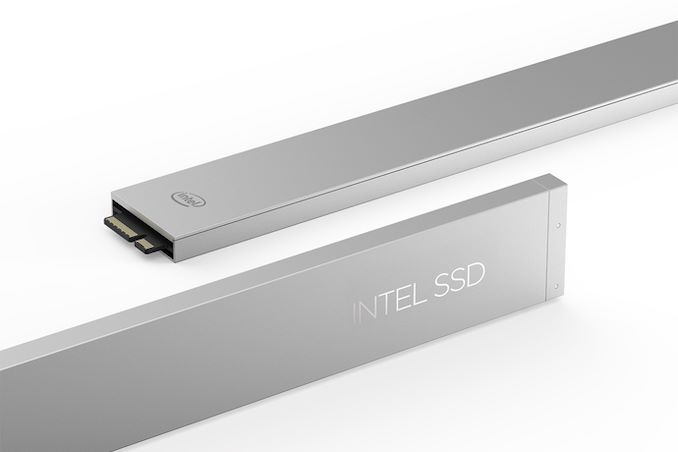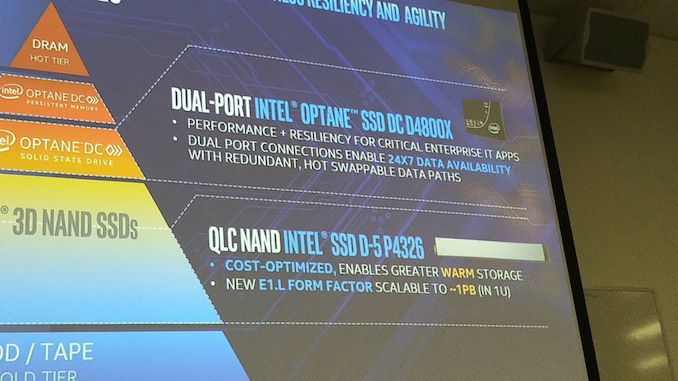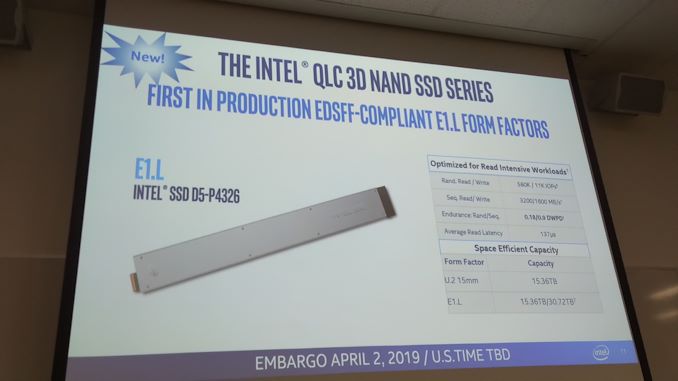Intel Announces New Optane And QLC Enterprise SSDs
by Billy Tallis on April 2, 2019 1:01 PM EST
Slipped in to the briefings for Intel's mountain of announcements today are two new enterprise SSDs at opposite ends of the product line: a new Optane SSD and a new QLC NAND SSD.
Intel Optane SSD DC D4800X
The new Optane SSD DC D4800X differs from the existing P4800X by adding support for dual-port PCIe operation (for high availability) when attached through a PCIe fabric that provides redundant data paths. Most of Intel's NAND-based enterprise NVMe SSDs have dual-port counterparts, but this is the first time this feature has shown up in the Optane product family.
Dual-port support is a relatively niche feature, to the point that many of the current-generation dual-port drives aren't listed on ark.intel.com, and we don't have detailed specifications. Performance will be a bit constrained when using just one of the PCIe 3.0 x2 links, but most of Optane's advantages in latency and random IO throughput will be retained. While the performance-oriented P4800X is available in both U.2 and add-in card form factors, the dual-port capability only makes sense for the hot-swappable U.2 form factor (and potentially EDSFF in the future).
The addition of the dual-port Optane drive indicates that Optane SSDs are reaching a broader audience that now includes mission-critical systems that need high performance but aren't seeking maximum performance to the exclusion of all other factors.
Intel SSD DC D5-P4326
Intel's lineup of enterprise/datacenter SSDs that use four bit per cell QLC NAND flash memory is also expanding. Joining the 7.68TB SSD D5-P4320 announced last fall is the new SSD D5-P4326 with 15.36TB and 30.72TB usable capacities. Intel claims these are the first drives in production that comply with the EDSFF E1.L form factor standard, derived from Intel's earlier "Ruler" concept. The smaller 15.36TB capacity is also available in 2.5" 15mm U.2 form factor. That 15.36TB model was mentioned earlier this year as available for "limited deployments", but Intel is now ready to scale up their efforts.
Compared to Intel's 7.68TB P4320, the larger P4326 drives have improved random read and sequential write performance, while sequential read performance is unchanged and steady-state random write speeds fall significantly to just 11k IOPS. These drives offer the lowest performance and endurance but highest density in Intel's SSD product line: the 30.72TB model allows Intel to reach the goal of 1PB (raw capacity) of flash storage in a 1U server, thanks to the slim EDSFF form factor. Performance per TB is down relative to the smaller P4320, so the P4326 is even less suited for storing hot data, but it still offers a compelling performance advantage over mechanical hard drives, and the write endurance does scale in proportion to capacity: 0.18 drive writes per day for random I/O, and 0.9 DWPD for sequential I/O.
Source: Intel












27 Comments
View All Comments
stephenbrooks - Wednesday, April 3, 2019 - link
The other way of doing it is to make the NAS the backup while the big drive in your PC is the fast access. That way you can do automatic backups too (although watch out for corner cases like if the PC's disk goes offline it doesn't try to empty the NAS too).Greg100 - Wednesday, April 3, 2019 - link
Why bother with NAS, when I have offline drives for backup? I do manual backup. It is very easy for me. I do not trust automatic backup software. Everything I do manually with help of HashCheck, SFV Ninja, PathLengthChecker and WinDirStat. I like to have everything under MY control.I use “User Profile Personal Folders” in Windows 10 only as short, temporary folders. I move everything to “real” my folders without any desktop.ini files.
Each my main folder has checksum file made by HashCheck.
There is hot folder which has files that I change everyday and there are also cold folders.
So I copy only folders which changed. Than SFV Ninja check all backup files with checksum files from main drive. So that way I check also backup files integrity. Next time I use second backup drive, which is stored in different building (fire or thief risk)
Having offline backup also eliminate electricity risk (thunder storm risk).
azazel1024 - Wednesday, April 3, 2019 - link
All of your data on one dedicated network storage device is still a good way to lose it.My storage and backup strategy is that my desktop has 2x3TB Seagate Baracudas in RAID0 for performance. My server carries all of that mirrored data with the 2x3TB RAID0 setup. I back things up every 1-2 months on to a 5TB external HDD and keep it in a fire safe.
Good performance, redundancy and availability.
At some point I'd like to switch to a 2.5 or 5GbE network (current is 2x1GbE) and also SSD bulk storage. I don't NEED 500+MB/sec of performance on my network or storage, but I'd sure like it. I don't often sit there when I transfer large files, but I do occasionally move a 4K video file or what not and twiddling my thumbs as a 18GiB file transfers over my network can be annoying (oh noes, I have to wait about 80 seconds!)
dwbogardus - Thursday, April 4, 2019 - link
Just a comment about fire safes: If the fire department can get it put out in less than an hour, you may have something left. But the giant fires last summer that wiped out entire neighborhoods and towns created their own firestorms, with heat so intense that nothing could be done. All that was left was foundations and chimneys, and a few inches of ash. Your best fire safe would be in a bank vault's safe deposit box. Something to think about in light of recent events...melgross - Wednesday, April 3, 2019 - link
A NAS is really slow. There are a lot of uses for which it’s the worst solution. I do agree that a very large, by today’s standards, and expensive SSD isn’t a great solution, if we’re talking cost.Seriously, content doesn’t require a fast drive. Unless you’ve got several people pounding on it at the same time, the slowest archival HDD is more than fast enough. 8TB costs just a bit more than $200. Put a couple together and you’ve got way more than you need. Back that up with a couple more, and you’re set. The whole thing can cost a bit over $1,000. If 16TB of storage, plus 16TB backup isn’t enough, then you’ve got too much junk to watch.
AdditionalPylons - Wednesday, April 3, 2019 - link
I completely agree with JoeyJoJo123.There is very little point putting "Personal video, photo and music" on SSDs. They simply don't need the bandwidth. (You would actually be very well served with SATA SSDs.)
The way I see it there are only three reasons for putting huge media collections on SSDs:
1) If you do a lot of video editing. (But even then you should probably prioritise and keep only the most frequently used on SSD and move the files to a NAS/DAS when you've finished editing that project.)
2) If you need to carry it with you in a laptop, because SSDs have higher storage density and are less likely to break from accidental drops or heavy handling.
3) Noise from spinning drives. (Not a concern with a NAS as you can place it wherever you pull a network cable.)
While I understand that it is indeed convenient to keep the files on internal drives the traditional way, I would, just like JoeyJoJo123, really recommend anyone who has more than a few TB of data to go for a NAS.
That would give the added convenience of the following features (if you wish to have them, or if your user needs change):
- A redundant storage system.
- Good options for automatic offsite backups to other NASes or cloud services.
- Allows accessing your files from smartphones, tables on the go.
- Easily setting up your own cloud storage with sync (like your own Dropbox).
- Various media center/HTPC apps.
- Other services like web server etc.
And that is even before mentioning any feature that is handy for multiple users (families or sharing with friends).
If you are worried about data integrity you could consider a NAS which features regular checksums on the filesystem level, such as with ZFS or BTRFS.
Moving away from local storage is a big step. It can sometimes feel like you lose a bit of the control when you're moving your files to a new operating system, but I think that the added features outweigh the inconvenience.
Good to hear that you have a good backup strategy. That would be my other concern with using single large drives of any type.
PeachNCream - Wednesday, April 3, 2019 - link
I would find a way to reduce my local storage needs were I in a situation where I had to find a home for so much data, but to each their own. A NAS is fine if you have a reason to share data between multiple devices and potentially multiple people, but regardless of whether or not a drive is stuffed into a NAS, a desktop, or your laptop there is still a purchase of said storage that must be made regardless. Why add the burden of a NAS when you're only serving files to yourself?Greg100 - Wednesday, April 3, 2019 - link
PeachNCream, good point! I do not share anything online, I do not stream and I do not use social media. All my family and friends are welcomed to my living room when we can socialize and watch all my media.Greg100 - Wednesday, April 3, 2019 - link
You are right AdditionalPylons about three reasons for putting huge media collections on SSDs:1) video editing
2) moving computer to another building
3) silence
There are couple more, but all three above are important for me.
And yes, ZFS would be nice, if Windows 10 could use it. I do not want too bother with Linux or other exotic OSes, which can handle this. I like simplicity and full control for everything. And If something work for me for years I do not need any new “big step”. Like I said in another post I do not upload to social media, need any internal network, so why complicate myself live? I would like to have everything in one drive in one computer, except backup.
jordanclock - Wednesday, April 3, 2019 - link
The reason you're not going to find what you want is because the vast majority of users, both consumer and enterprise, are going to use HDDs for that use case. There is no benefit to using SSDs unless you frequently pull down many gigabytes of your media at a time. HDDs have better $/GB and better understood failure patterns/rates.